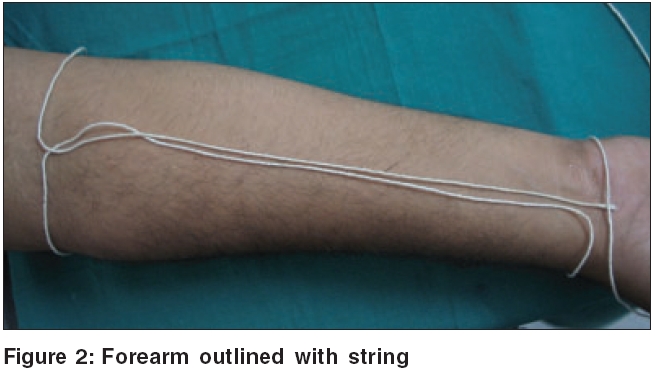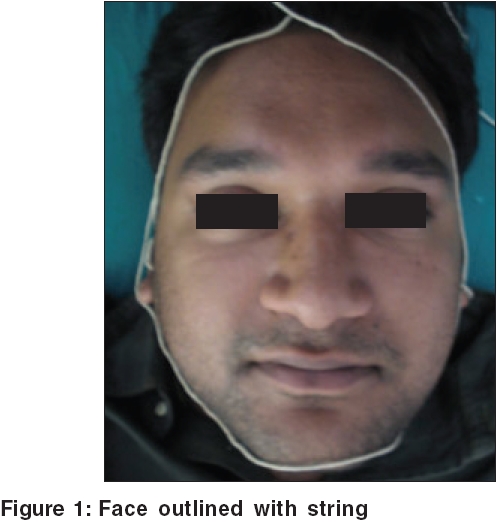Translate this page into:
Sunscreen application: Not less, not more
Correspondence Address:
C R Srinivas
Department of Dermatology, PSG Hospitals, Coimbatore - 641 004, Tamil Nadu
India
| How to cite this article: Srinivas C R, Lal S, Thirumoorthy M, Sundaram SV, Karthick PS. Sunscreen application: Not less, not more. Indian J Dermatol Venereol Leprol 2006;72:306-307 |
 |
 |
 |
 |
Sir,
Sunscreens are being increasingly used all over the world. Information regarding quantity of sunscreen to be used during each application is not easily available. The prescribed amount, 2 mg/cm 2 makes little practical sense to the patient. Studies have shown that consumers apply much less than this,[1],[2],[3],[4],[5] typically between 0.5 and 1.5 mg/cm 2. We undertook the study to evolve a practical, simple, and rapid guide, to advice patients on the quantity of the sunscreen to be used during each application. The study was conducted on 10 male and 10 female volunteers. The area of the face was measured by placing a wet thread along the outer margin of the face [Figure - 1]. The length of the thread was measured in centimeters. We assumed that the circumference of the face would be nearly equal to the circumference of the thread, if arranged as a circle. The radius and the area of the circle was calculated by dividing the circumference by 2p. The area of the face was then calculated by using the formula pr 2. Since 2 mg/cm 2 is the recommended dose of sunscreen for topical application, and 2 mg/cm 2 is equal to 2 micro liter/cm 2, the area of the face was multiplied by 2 to determine the amount of sunscreen in micro liters, which was then converted to milliliters. The mean circumference of the face of 10 male volunteers was 100 cm, and of 10 female volunteers was 81 cm. The mean radius was determined as 15.9 cms for males, and 12.98 cms for females. Based on the circumference and radius, the area of the face was 793.82 sq cm for males, and 530.6 sq cm for females. Since 2 micro liter/sq cm is the quantity of sunscreen required (2 x 793.82 = 1588 milliliter) i.e., approximately 1.6 ml of sunscreen will be needed for males, and for females, 2 x 530.6 = 1062 milliliter, that is approximately 1 ml will be needed.
The steps that are involved in the calculation are outlined for easy understanding.
Circumference (C) = 100 cms =2πr. Radius(r) = Circumference/2 π 100/2 x 22/7=100 x 7/2 x 22=15.9 cms
Area=πr 2=22/7 x 15.9 x 15.9 = 3.14 x 252.81 = 793.82 =794 sq cm. The calculation can be further simplified as follows. Area=C 2/4π.
The numerator in the formula for area is: C 2=100x100 = 10000. The denominator in the formula is: 4 x π = 12.566, therefore area = 10000/12.566 = 795.8 sq cm. Stated as a thumb rule, area is equal to square of circumference divided by 12.566 or 12.6.
Sunscreens are expensive, and have to be applied repeatedly. Less amount of sunscreen than the recommended quantity makes the sunscreen less effective. Excessive quantity makes the sunscreen more expensive, and also more uncomfortable. We calculated that the mean cost of 1 ml of sunscreen of 10 brands is approximately Rs. 3 to 4. It is more expensive if the patient uses the sunscreen repeatedly, or in excessive quantity. We recommend 1 ml of sunscreen for the female, and 1.5 ml for the male during each application. It is possible to calculate the sunscreen to be applied over any given area e.g., arm, back, etc. [Figure - 2] shows how a string is placed over the forearm. The same length of thread can be arranged in form of a circle. Once the area is determined, the amount of sunscreen can be easily calculated. This method actually measures the perimeter of the skin, and assumes it to be a circle. In general, an oval surface would encompass a lesser area than a circular surface of the same perimeter. This method would thus result in a larger calculated area than the actual, and in the case of the forearms, we would use more sunscreen than is necessary. However, this may not make a significant difference.
We do not feel justified to recommend specific amount of sunscreen for the exposed area of arms, and upper and lower back, as there would be a considerable individual variation in the area exposed to sunlight. The string method can also be helpful in keeping track of increase or decrease in various irregular shaped skin lesions including ulcers.
Acknowledgments
Dr. Sasidharan Nair, Professor, Department of Physics, PSG Technology, Peelamedu, Coimbatore.
| 1. |
Azurdia RM, Pagliaro JA, Diffey BL, Rhodes LE. Sunscreen application by photosensitive patient is inadequate for protection. Br J Dermatol. 1991;140:255-8.
[Google Scholar]
|
| 2. |
Bech-Thomsen N, Wulf HC. Sunbather's application of sunscreen is probably inadequate to obtain the sun protection factor assigned to the preparation. Photodermatol Photoimmunol Photomed 1993;9:242-4.
[Google Scholar]
|
| 3. |
Diffey BL, Gride J. The influence of sunscreen type of photoprotection. Br J Dermatol 1997;137:103-5.
[Google Scholar]
|
| 4. |
Gottlieb A, Bourget TD, Lowe NJ. Sunscreen: effects of amounts of application of Sun Protection Factors. In: Lowe NJ, Shaath NA, Pathak MA, editors. Sunscreens: development, evaluation and regularly aspects. New York: Marcel Dekker; 1997. p. 583-8.
[Google Scholar]
|
| 5. |
Stenberg C, Larko O. Sunscreen application and is importance for the Sun Protection Factor. Arch Dermatol 1985;121:1400-2.
[Google Scholar]
|
Fulltext Views
3,313
PDF downloads
1,671





